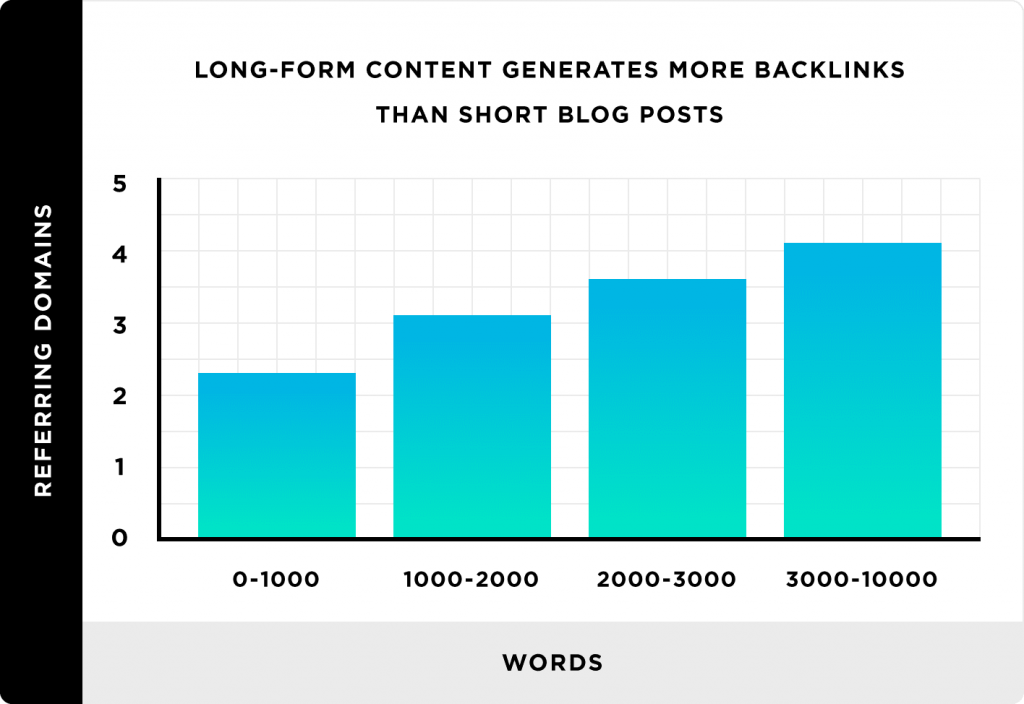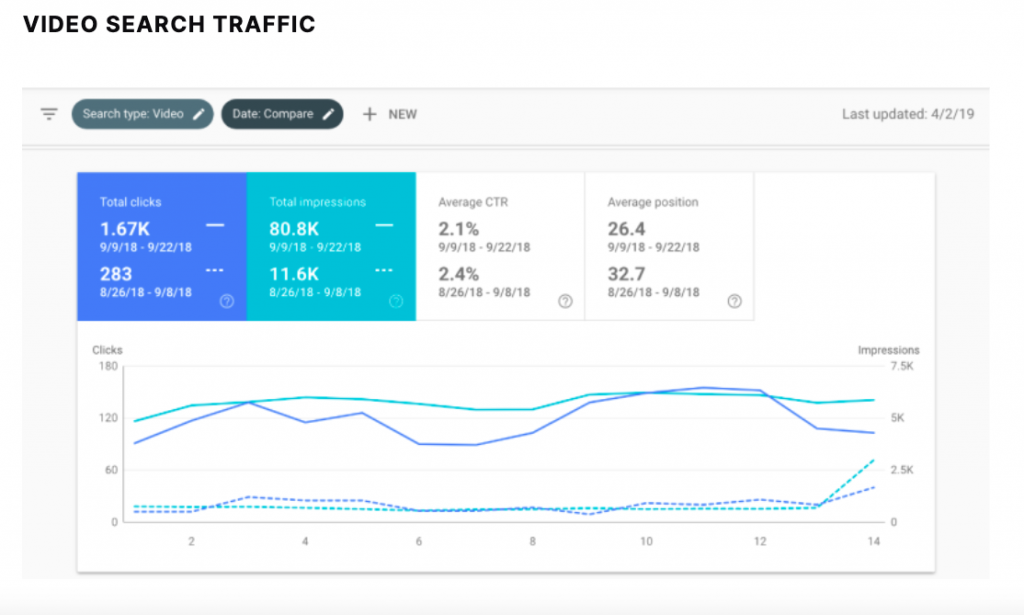10 Strategies to Increase Organic Traffic to Your Website in 2021

Marketing teams continually aim to generate more organic search traffic, because organic search drives 51% of all web traffic and 40% of revenue. Backlinko reports the first organic Google search result fetches a CTR of 31.7%. That is obvious since users tend to click on the first few results instinctively.

Rank in the top 3 positions or featured snippets for a particular keyword and you will see an exponential traffic jump. However, if you fail to rank on page one, it is a missed opportunity to improve the website click-through rates.
Here are the 10 strategies to increase your website’s organic search traffic in 2021.
1. Write long-form content (often, but not always)
A study by Backlinko found longer content receives more backlinks. This can lead to better ranking and more traffic.

However, writing 2,000+ word blog posts is time-consuming and not for everyone. Remember that your content should satisfy user intent. For some search queries the readers might want a guide. For others, they may be looking for a few words to answer their question.
For “link building do’s and don’ts” chances are the reader would not be looking for a detailed guide. A simple bullet-point list would suffice.
On the other hand, for the keyword “link building tips” people could be looking for a comprehensive guide to link building strategies.
You could consider targeting multiple types of search queries in a single post. For example, the link building guide could have a table of do’s and don’ts. Your content marketing funnel should have high-quality content, regardless of the format or length.
In 2021, a content marketing strategy worth trying is to refresh your old content. Why not expand an existing blog from 1,500 to 2,500 words? Because your existing content has authority and readership, it is simpler to refresh and update existing information with extra content.
Content refreshes work great for time-sensitive content pieces such as “listicles or statistic” posts.
You could also consider supercharging your content with quizzes to make the content interactive and engaging.
2. Improve site architecture to get sitelinks
Site architecture signals how crawlers can access your website and how human searches can navigate and engage with it. If your site architecture is confusing, crawlers would not know which pages are more important to your website. When users cannot find the information they need, they would bounce from the site. This sends negative signals to search engines, which is why your site drops in SERPs.
The benefit of good site architecture is that it boosts organic traffic by positioning your website higher in results. This increases the chances of having your sitelink featured in SERPs and increased conversions.
Sitelinks also take up valuable real estate on the results page, give searches more chances to click through to your page, and push competitor listing below the fold.
How can you improve site architecture and get sitelinks?
A good site architecture has a logical flow of URLs, moving from domain to category and subcategory. Tips to improve site architecture include:
- Large sites should be organized into meaningful categories and subcategories.
- Pay attention to the internal site linking structure. Crawlers need links to hop from one page to another on the site. A lack of links could result in some pages becoming uncrawlable.
- Add a sitemap. The sitemap.xml file extension signals to crawlers the most important pages on your website which you want to appear in sitelinks. You could add a sitemap to your Google search console account.
3. Use long-tail and relevant keywords
Everyone talks about keyword optimization, but not enough people talk about long-tail or query-based keywords. Research and optimize your blog posts with these keywords to boost the volume of organic search queries you rank for.
Long-tail keywords are typically indicative of higher buying intent. For instance, someone who searches for “best running shoes under $100” is more likely to buy than someone who searches for just “shoes.” There is less competition for long keywords because they are more descriptive. By ranking for long-tail keywords relevant to your niche, you attract customers who are much closer to making a purchase.
You can use a keyword database to find actionable data about the keywords. From the basic Google ad metrics to augmented benchmarks, extended keyword metrics and historical data, you can filter the keywords and sort them by specific metrics. This enables you to compare ideas and select the most powerful keywords for your brand.
How to use long-tail keywords?
Here is how you can incorporate them into your content:
- After finding the keywords, write content around that topic in the form of a blog post or a webpage.
- Incorporate those keywords in the title, header, meta description, image alt text, and throughout the text.
Google search provides alternative keywords to searchers. As these suggestions are based on real queries, they are an excellent place to find related searches.
4. Have catchy but simple title tags
Most of the time, people will click on your link in the search engine results based on what they can see in the title. Some ways to make your titles more ‘clickable’ include using a numbered list, using brackets in the headline (a HubSpot study found that this boosted clicks by 40%), mentioning the current calendar year, and avoiding heavy title tags. Of course, be sure to test all of your headlines and pick the ones that work best.

5. Make your URLs descriptive
The third component of the preview text that your customers see in search engine results is your page URL. Moz first talked about the importance of descriptive URLs back in 2014.

Today, website URLs play a key role in search rankings. By adequately categorizing and sub-categorizing your pages, you can add more keywords to your URL and show your customers that they are looking at precisely what they searched for.
When you make the URL descriptive and add SEO-friendly meta tags, title tags, and meta, you optimize for click-through rate (CTR). Visibility on page one is only half the organic search traffic battle. Alongside, you need to convince searchers to click on your results than the other options.
The two benefits of optimizing for CTR include:
- Enticing searchers away from competitor sites to your own site, thereby increasing your organic traffic.
- Sending positive signals to search engines. Google prioritizes search results based on high CTR.
6. The impact of videos on search performance
Having a video on your website or web pages helps you get traffic from video-specific searches. Additionally, it can increase the relevancy for certain queries, thereby increasing the rankings and visibility.
When Wistia indexed their videos, they received 6,100 clicks from search and 1,387 direct clicks from video search. The indexed videos increased their organic search traffic by 10.6%.

That means, your website traffic will see a positive impact by including indexable video content on your website.
InVideo helps you create and edit online videos that look dynamic, appealing, and demand attention.
7. Optimize your content for featured snippets
One of the best ways to improve your website’s visibility is by showing up in featured snippets. This is the most appropriate answer to a user’s search query, according to Google, and appears at the very top of search results. A featured snippet can have diverse content formats such as a short paragraph, lists, tables, videos, or even images.
Users are much likelier to click on the first result they see. Plus, the fact that Google has chosen your website out of all the hundreds of others to be at the top indicates that you are trustworthy and share useful content.

How to dominate featured snippets?
As with sitelinks, featured snippets have to be won. You cannot request Google to give you a featured snippet. To increase your chances of appearing in a snippet, you can follow some steps. They include:
- Sites that do not appear on page one will not appear in a snippet. Find out the keywords that rank for the featured snippet and if your website is ranking on the first page for it.
- Snippet-friendly keyword phrases answer a question (how, why, or what). Your content should answer that question.
- Structure your answer for crawlers. The question should be in the H2 subheading, The answer should be in the text directly below the H2 heading with <p> mark-up.
- Format the content as steps. This copywriting tip makes your content more reader-friendly and boosts the chances of ranking for featured snippets.
Even if your content does not rank for featured snippets, these strategies will improve the performance by making the content more crawlable and sharable. The ultimate goal is to gain brand exposure and increase the online visibility of your business.
8. Repurposing content for other channels
Repurposing a single content piece into multiple formats makes sense as you spend lots of time and effort creating a piece of content. Don’t neglect it after hitting the “publish.”
Extend its shelf life by turning it into different content formats. The reason being, people consume content differently. While some prefer audio, others prefer visual or some like me, prefer to read.
Gary Vaynerchuk uses the following content pyramid for content repurposing.

Here’s the slide deck that explains his process.
While GaryVee has a team that helps him repurpose content, it doesn’t mean you can’t do it. Calibrate your expectations and resources and you are good to go.
9. Build a diverse backlink portfolio with writing guest posts
Even in 2021, backlinks are a crucial part of search engine optimization. And guest blogging where you write for other blogs have several benefits:
- More referral traffic
- More backlinks and link building opportunities
- Increased brand awareness
Keep in mind, the quality of backlinks matters. Spammy links do more harm than good.
When pitching guest posts, don’t only target the “big-hitters.” Smaller sites are also valuable. They are more responsive to your pitches and niche-specific.
From personal experience, here are some guest blogging best practices to follow:
- Invest time in creating high-quality content. Build a portfolio of awesome guest posts in well-known industry blogs and use it as social proof. This can help you get a green light from publications that usually decline guest posts.
- Publishing a guest post doesn’t happen in a day. It can take 3-4 weeks because your post isn’t usually at the top of the blogger’s to-do list. Find out 3-4 topics you would want to write about and pitch them to 5-7 blogs.
- Interlink to your previously published guest posts. I use this opportunity to link to those in the industry I would want to build a relationship with.
- For each article, link to different pages from your website.
10. Referral marketing to reward loyal customers
One of the KPIs for every marketer to increase the volume of search traffic to their website. The problem with digital marketing strategies is that SEO takes time. PPC is costly. Social media has a limitation in terms of ROI.
Referral traffic, on the other hand, has the potential to generate practical traffic and multiply sales quickly. Because the majority of people trust recommendations from friends and family over advertisements, referral marketing not only boosts your revenue but also the brand name.
Reward your most loyal customers. Acknowledge their loyalty and increase conversions with incentive referrals. Xoxoday Plum helps you streamline and automate referral programs with instant rewards and benefits. The catalog of 15,000+ products and experiences ensures that your customers receive a reward that is not repetitive or irrelevant.
Final thoughts
We know that SEO is constantly evolving. Marketers need to adapt fast and giving your website an edge over the competition is very much in your control. Increasing organic traffic starts with spending time on the fundaments of solid content creation. Stay on top of the impact of backlinks, schema, featured snippets, and site architecture. When you implement these basics of SEO, you will see a significant difference in your website’s click-clickthrough rate, engagement, and rankings.
Photo by Le Buzz on Unsplash